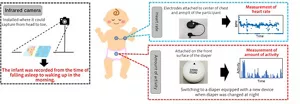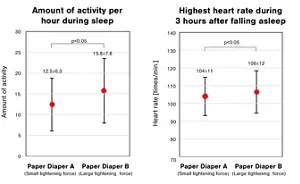Confirmation of the Effects of Tightening around the Abdominal Region by Paper Diapers on Infants' Sleep
The Sanitary Products Research Laboratory of Kao Corporation has examined the effects of tightening of paper diapers around the abdominal region on infants' sleep jointly with the United Graduate School of Child Development, Osaka University (Professor Masako Taniike and Associate Professor Ikuko Mohri). The results revealed that the amount of activity as well as the heart rate decreased during sleep when infants wore a paper diaper with a small tightening force. Furthermore, the number of arousals during sleep*1 tended to be lower, and the wake-up time became earlier. It is assumed that the lack of tightness may have increased periods of deep sleep and improved the quality of sleep.
These findings of this study were presented at the 69th Annual Meeting of the Japanese Society of Child Health (June 24 to 26, 2022, Mie Prefecture/online hybrid meeting).
-
* 1 The arousal during sleep is defined as an awakening for 6 minutes or longer between the time of falling asleep and the time of waking up in the morning.
Study of sleep in infants
As basic research for developing paper diapers for babies, Kao Corporation has studied various aspects to better understand infants. A part of this research is a study on sleep in infants. It is difficult to evaluate sleep in infants, and few studies have been conducted on sleep in healthy infants.
Evaluation of the effects of tightening around the abdominal region with paper diapers on infants' sleep
Fourteen infants aged 6 to 12 months, whose awakening–sleep rhythm throughout the day was becoming established, were recruited in this study. Informed consent was obtained from their caretaker. This study was conducted at home under the ordinary sleeping environments, and take physiological measurements.
The caretakers of the participants were asked to use each of the shorts-type paper diapers with different tightening forces on the abdominal region (Diaper A, small tightening force; Diaper B, large tightening force, Figure 1) for five weekday nights, record a video of the infant by an infrared camera, and measure the amount of activity and heart rate by attaching measuring instruments on the infant during sleep for three of the five nights (Figure 2). The caretakers were also asked to keep a sleep diary and fill out questionnaires before and after the tests.

Figure 1: Difference in marks made by the rubber with different levels of tightening force of the paper diaper on the abdominal region (clear examples)
Days on which health was not good judged by the sleep dairy or video data were excluded from the analysis, and 11 infants were subjected. The amount of activity, heart rate of 3 hrs. after falling asleep, and number of arousals during sleep, wake-up time were compared between two types of diapers.

Figure 2: Physiological measurements of infant's sleep
Smaller tightening force improved quality of sleep
The evaluation of the effects on sleep revealed that both the amount of activity per hour during sleep and the highest heart rate during the three hours after falling asleep decreased when infants wore Diaper A than Diaper B (Figure 3). Since the amount of activity of children during sleep decreases with deeper sleep, it indicates increase of deep sleep. In addition, compared to Diaper B, when infants wore Diaper A, the highest heart rate was lower in the period considered to non-REM sleep*2 indicates that the activity of the sympathetic nervous system*3 was lower, which suggests that the quality of sleep was better.
-
* 2 This is a deeper state of sleep in which the brain activity is reduced compared to REM sleep, which involves higher brain activities even when the person is asleep. It serves to allow the brain and body to rest. It usually appears immediately after falling asleep.
-
* 3 A type of autonomous nerve which functions when the person is active or under tension or stress.

Figure 3: Amount of activity and heart rate during sleep
Furthermore, sleep onset latency and the number of arousals during sleep showed a tendency to decrease, and wake-up time became earlier when children wore Diaper A (Figure 4). The earlier wake-up time may result from better sleep.

Figure 4: Number of arousals during sleep and wake-up time
Summary and future plans
This study confirmed that tightening around the abdominal region by paper diapers affected the sleep of infants. Use of a paper diaper with a small tightening force may have improved the quality of sleep by increment of deep sleep. These findings will help advance the development of paper diapers which allow them to sleep comfortably. Kao Corporation will continue to work on manufacturing products that improve the quality of sleep for infants and contribute to their healthy growth.
Comments from Associate Professor Ikuko Mohri, United Graduate School of Child Development, Osaka University

Sleep is extremely important for the development of the brain. In recent years, it has been shown that sleep of a sufficient length and quality is necessary during infancy, when the brain develops most rapidly. The environment surrounding the infant is also important in ensuring good sleep. The wearing feel of the diaper, which comes into direct contact with the body, is an environmental factor that is extremely important for infants. It has been reported that paper diapers induce better sleep than cloth diapers. However, improvements to paper diapers have been made mainly based on the standpoint of the parents, pursuing resistance to leakage, ease of putting it on the infant, etc. Since infants cannot express themselves in words, it is extremely difficult to evaluate the comfort from the infants' standpoint. This study evaluated the wearing feel of paper diapers from the infants' standpoint based on whether they were sleeping well, and found that a diaper with a smaller tightening force on the abdominal region allowed them to relax more during sleep, or sleep well, which could have a significant effect on infants' development in the future. Caretakers should select diapers that place the least burden on infants, including tightness, while ensuring that the type fits the body size. I hope that the results of this study will be used to develop diapers that induce better sleep in the future.
About Kao
Kao creates high-value-added products and services that provide care and enrichment for the life of all people and the planet. Through its portfolio of over 20 leading brands such as Attack, Bioré, Goldwell, Jergens, John Frieda, Kanebo, Laurier, Merries, and Molton Brown, Kao is part of the everyday lives of people in Asia, Oceania, North America, and Europe. Combined with its chemical business, which contributes to a wide range of industries, Kao generates about 1,420 billion yen in annual sales. Kao employs about 33,500 people worldwide and has 135 years of history in innovation. Please visit the Kao Group website for updated information.
Media inquiries should be directed to:
Corporate Strategy
Kao Corporation
